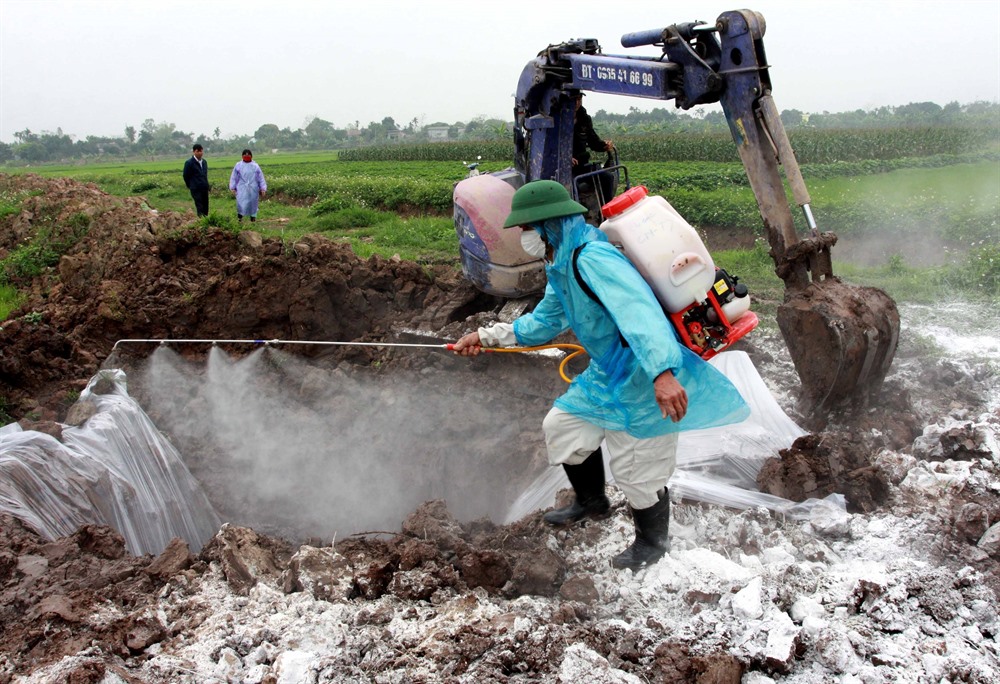 Society
Society

Pig-farming Từ Tây Ward in Yên Phú Commune, Yên Mỹ District, the northern province of Hưng Yên, is going through hard times, with farmers forced to cull hundreds of pigs infected with African swine fever every day.
 |
| A worker sprays disinfectant at a pig burial site in Hưng Hà District, Thái Bình Province. The province is one of 16 localities affected by the disease. — VNA/VNS Photo Thế Duyệt |
HƯNG YÊN — Pig-farming Từ Tây Ward in Yên Phú Commune, Yên Mỹ District, the northern province of Hưng Yên, is going through hard times, with farmers forced to cull hundreds of pigs infected with African swine fever every day.
There are 50 households with some 10,000 pigs in the locality.
On Wednesday – the second day after the epidemic was found in Yên Phú Commune – local authorities mobilised forces from the commune veterinary service and police to monitor the destruction of Dương Văn Tâm’s herd, including three sows, 18 cubs and 42 pigs that tested positive for the virus.
Tâm told Thanh niên (Young people) newspaper that when the neighbouring ward of Yên Hoà found an outbreak of the diease, each household contributed VNĐ1 million (US$43) to buy lime powder, spray disinfectant and set up five 24-hour quarantine checkpoints around the ward to prevent vehicles from transporting sick pigs to the area.
Even traders cannot enter the ward without permission.
“We have spent 20 days guarding and protecting our herds but the disease broke out anyway and spread rapidly,” he said.
Lê Văn Viên, another resident, was waiting for his herd of 27 sows and some 200 cubs to be culled.
“A sow sells for VNĐ16 to 17 million (US$688 to 731) while a cub is valued VNĐ1.3 million to 1.4 million ($56 to 60),” Viên said. “Including the cost for animal feed, the loss may be VNĐ800 million ($34,000). All our fortune just evaporated.”
Pulling out all the stops
In the past three days, six outbreaks were found in Từ Tây Ward.
More than 400 infected pigs need to be destroyed.
On Wednesday, the commune’s People’s Committee mobilised all its forces but only could handle two outbreaks with a total of 150 pigs.
Lê Văn Giới, the ward head, said ill pigs were piling up despite their enormous efforts to destroy them.
To minimise the need to transport infected animals, households were instructed to bury infected pigs at their farms if possible.
There is also a concentrated burial site for small households to destroy sick pigs.
Phạm Trần Hoạt, head of Yên Mỹ District People’s Committee, said that as of Tuesday afternoon, some 2,800 pigs had been buried.
The local budget of VNĐ7 billion ($301,000) is enough to buy and spray disinfectant chemicals, but not enough to support farmers who have infected pigs.
Earlier last week, Prime Minister Nguyễn Xuân Phúc agreed to provide impacted pig-farming households with at least 80 per cent of the market value lost for meat pigs and from 1.5 to 1.8 times the market value for sows.
However, as no official document has been released, localities have offered payment of VNĐ38,000 ($1.60) for each kilogram of pork.
The latest outbreak of African swine fever was found on Wednesday at Hoàng Văn Lan’s farm in Quỳnh Mỹ Commune, Quỳnh Lưu District in the central province of Nghệ An, raising the number of affected localities to 16.
According to the World Organisation for Animal Health (OIE), African swine fever is a fatal infectious disease caused by a virus which spreads rapidly among pigs.
The OIE estimates that since early 2017, as many as 20 countries have reported African swine fever and more than one million pigs have been culled.
There are three main factors in the spread of African swine fever: unsterilised vehicles and people, feeding leftover food to pigs and the transportation of infected animals. — VNS




